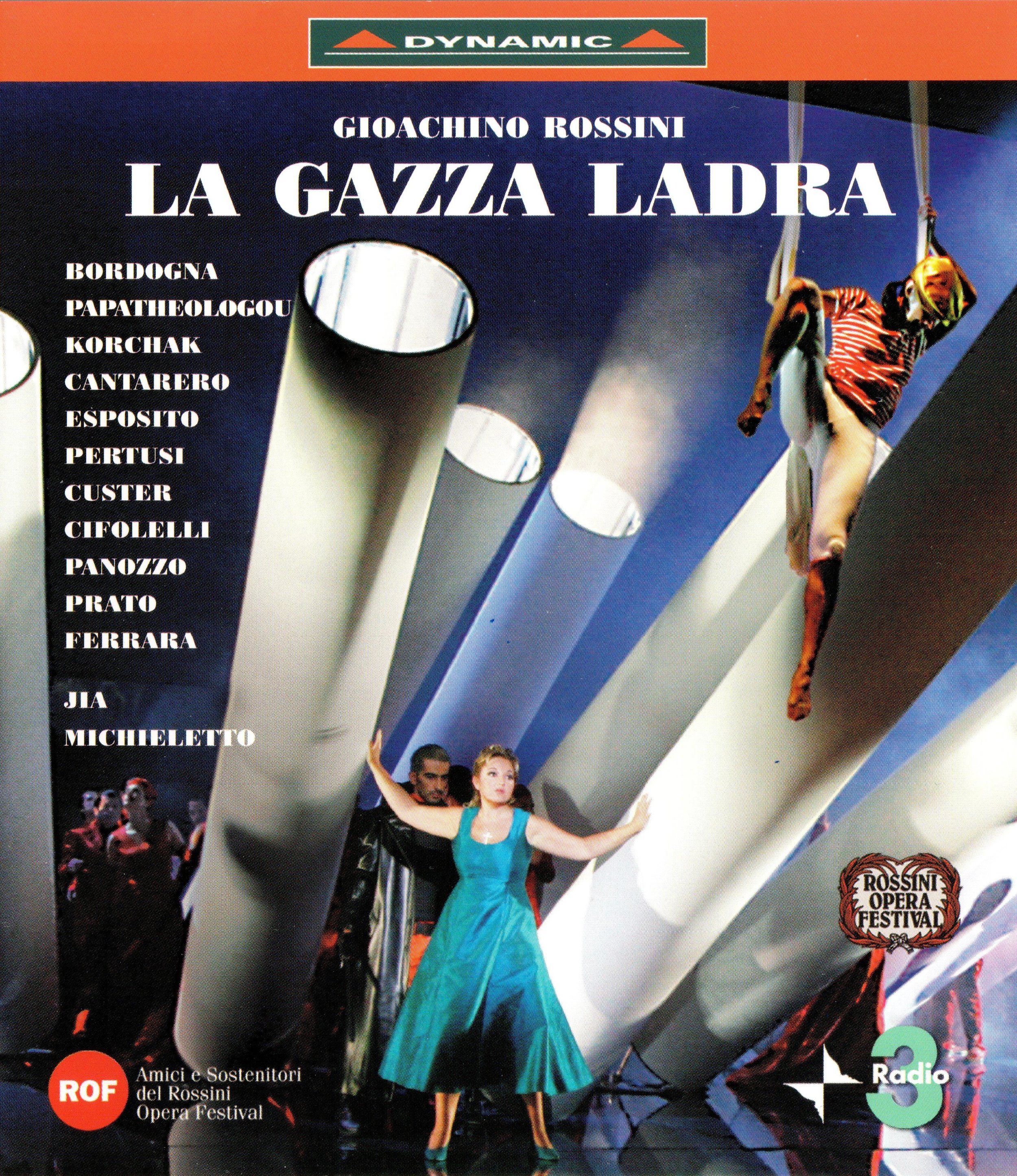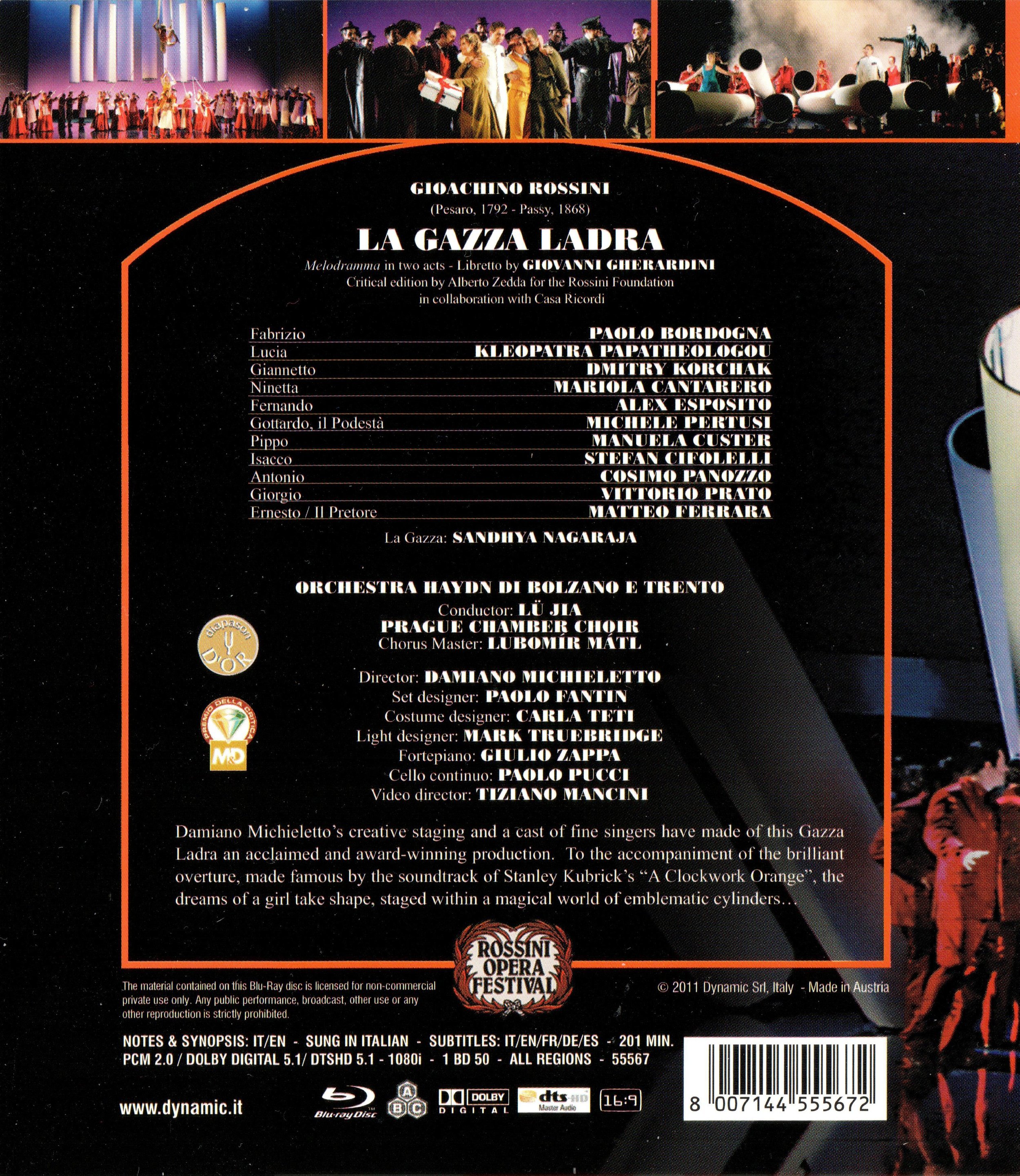

Rossini La gazza ladra (The Thieving Magpie) opera to a libretto by Giovanni Gherardini. Directed 2007 by Damiano Michieletto at the Rossini Opera Festival in Pesaro, Italy (Rossini's birthplace). Stars Paolo Bordogna (Fabrizio), Kleopatra Papatheologou (Lucia), Dmitry Korchak (Giannetto), Mariola Cantarero (Ninetta), Alex Esposito (Fernando), Michele Pertusi (Gottardo, the Mayor), Manuela Custer (Pippo), Stefan Cifolelli (Isacco), Cosimo Panozzo (Antonio), Vittorio Prato (Giorgio), and Matteo Ferrara (Ernesto/Magistrate). Dancer Sandhya Nagaraja stars in the non-singing role of La Gazza. Also features Giulio Zappa on fortepiano and Paolo Pucci on cello continuo. Lü Jia conducts the Orchestra Haydn di Bolzano e Trento and the Prague Chamber Choir (Chorus Master Lubomír Mátl). Set design by Paolo Fantin; costume design by Carla Teti; light design by Mark Truebridge. Directed for TV by Tiziano Mancini. Sung in Italian. Released in 2012, disc has dts-HD Master Audio sound. Grade: B+
This is a melodrama or opera semiseria—an idiotically contrived plot created purely as a platform to support silliness and possible yank tears. The story hinges on crimes committed by a bird, which lead to a multitude of fatal complications that can only be solved by a last-second pardon from the King. Piled on this we have 3+ hours of high-voltage Rossini orchestration and coloratura singing. So how do you balance off the inane story with the glorious music? Here Damiano Michieletto turns the entire story into a dream, which allows his crew to get away with a lot without seeming illogical.
Thank Goodness this was done in a real opera house (not at one of those outdoor festivals). This allows the magpie to really fly and for Paola Fantin to go crazy with his enigmatic cylinders, small and large. Light designer Mark Truebridge probably earned 3 times his fee, and Carla Teti managed to use something from every bin at her warehouse without looking silly. All the visual shenanigans are neatly and aptly captured by video director Tiziano Mancini, who is building an excellent reputation for great work at smaller venues. (See, for example, his Edgar and Thais at Regio Torino and his Turandot from Palau de las Arts.)
The dream conjured up by Michieletto has enough weight to support the singing, even for today's taste, which demands never to be bored. All the singers are fine for the light-weight nature of the project, perhaps in part because this production does not sap too much energy with acting demands. And the orchestra sounded brilliant throughout while never drowning out the singers.
Patrick Dillon wrote a perceptive review of this production in the July 2012 Opera News (page 52), and his comments fully support our B+ grade for this. The mission of the Rossini Festival is to revive and popularize Rossini's many lesser-known operas. So how can the Rossini Foundation best do this? Of course they have to stage stage good shows, and people will enjoy them in venues of maybe 800 to 2,000 seats for short runs in Pesaro. But what can the Foundation do after that to get more attention? You already know the answer: make a great HDVD of the show! Then over the years vastly more people will be able to enjoy this than can see it in the obscure Italian town of Pesaro.
This title was also a great move for Dynamic, a company that specializes in Italian opera. They gave a lot of legacy video in their vault, most of which will not be good enough to publish in Blu-ray (such as their crippled Madama Butterfly). But they will have the inside track on local jewels such as subject Gazza Ladra.
OR
